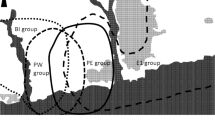Abstract
This study describes a case of adoption by a female tufted capuchin (Sapajus spp.) who spontaneously adopted a newborn immediately after he was abandoned, then raised him successfully with her own infant. For 7 weeks, we observed the adoptive mother, the adoptee (3 days old at the time of adoption) and the biological infant (4 days old) in order to compare the behavior of the female towards each infant. We focused our attention on different maternal behavioral patterns: grooming, carrying and cuddling behaviors, and we also considered suckling and independent locomotion by the infants. Our results showed no difference in the active care of the adoptive mother. The only significant distinction found between the two infants concerned suckling durations, which were seen to be longer for the adoptee than for the biological infant. We suggested that this could be linked to the gender of the infants, the male adoptee having greater need for milk than the biological daughter.




Similar content being viewed by others
References
Agoramoorthy G, Rudran R (1992) Adoption in free-ranging red howler monkeys, Alouatta seniculus of Venezuela. Primates 33:551–555
Clarke MR, Glander KE (1981) Adoption of infant howling monkeys (Alouatta palliata). Am J Primatol 1:469–472
Ellsworth JA, Andersen C (1997) Adoption by captive parturient rhesus macaques: biological vs. adopted infants and the cost of being a “twin” and rearing “twins”. Am J Primatol 43:259–264
Fairbanks LA (1993) What is a good mother? Adaptive variation in maternal behavior of primates. Curr Dir Psychol Sci 2:179–183
Fragaszy DM, Bard K (1997) Comparison of development and life history in Pan and Cebus. Int J Primatol 18:683–701
Fragaszy DM, Visalberghi E, Fedigan LM (2004) The complete capuchin: the biology of the genus Cebus. Cambridge University Press, Cambridge
Fucillo R, Scucchi S, Troisi A, D’Amato FR (1983) Newborn adoption in a confined group of Japanese macaques. Am J Primatol 5:257–260
Hansen EW (1966) The development of maternal and infant behavior in the rhesus monkey. Behavior 27:107–149
Hinde K (2007) First-time macaque mothers bias milk composition in favor of sons. Curr Biol 17:R958–R959
Hinde K (2009) Richer milk for sons but more milk for daughters: sex-biased investment during lactation varies with maternal life history in rhesus macaques. Am J Hum Biol 21:512–519
Hinde K, Milligan LA (2011) Primate milk: proximate mechanisms and ultimate perspectives. Evol Anthropol 20(1):9–23
Hobaiter C, Schel AM, Langergraber K, Zuberbühler K (2014) ‘Adoption’ by maternal siblings in wild chimpanzees. PLoS ONE 9(8):e103777
Holman SD, Goy RW (1988) Responses of foster-mothers and troop members to adopted newborns in a captive group of rhesus monkeys. Primates 29:343–352
Holzer Blersch B, Schmidt CR (1992) Adoption of an additional infant by a Western Lowland gorilla (Gorilla gorilla gorilla). Folia Primatol 58:190–196
Izar P, Verderane MP, Visalberghi E, Ottoni EB, Gomes de Oliviera M, Shirley J, Fragaszy D (2006) Cross-genus adoption of a marmoset (Callithrix jacchus) by wild capuchin monkeys (Cebus libidinosus): case report. Am J Primatol 68:692–700
Jay P (1965) Field studies. In: Schrier AM, Harlow HF, Stollnitz F (eds) Behavior of non-human primates, vol 2. Academic Press, New York, pp 525–591
Leighty KA, Byrne G, Fragazsy DM, Visalbergi E, Welker C, Lussier I (2004) Twinning in tufted capuchins (Cebus apella): rate, survivorship, and weight gain. Folia Primatol 75:14–18
Maestripieri D (2001) Is there mother-infant bonding in primates? Dev Rev 21:93–120
Maestripieri D (2011) Emotions, stress, and maternal motivation in primates. Am J Primatol 73(6):503–602
Maestripieri D, Megna NL, Jovanovic T (2000) Adoption and maltreatment of foster infants by rhesus macaque abusive mothers. Dev Sci 3:287–293
Manson JH (1999) Infant handling in wild Cebus capucinus: testing bonds between females? Anim Behav 57:911–921
Montagna W (1980) A case of adoption. Primate News 18:20
O’Brien TG (1988) Parasitic nursing behavior in the wedge-capped capuchin monkey (Cebus olivaceus). Am J Primatol 16:341–344
Ogawa H (1998) Adoption and social interactions between a mother and “twin” offspring in Macaca fuscata. Folia Primatol 69:100–105
Perry S (1996) Female-female social relationships in wild white-faced capuchin monkeys, Cebus capucinus. Am J Primatol 40:167–182
Powe CE, Knott CD, Conklin-Brittain N (2010) Infant sex predicts breast milk energy content. Am J Hum Biol 22:50–54
Siegel S, Castellan JN (1988) Non parametric statistics for the behavioral sciences. McGraw-Hill, New York
Smith S (1986) Infant cross-fostering in rhesus monkeys (Macaca mulatta): a procedure for the long-term management of captive populations. Am J Primatol 11:229–237
Thierry B (1985) A case of “transient adoption” in a captive group of Tonkean macaques (Macaca tonkeana). Lab Primate Newsletter 24:1–6
Thierry B, Anderson J (1986) Adoption in anthropoid primates. Int J Primatol 7:191–215
Timmermans PJA, Schouten WGP, Krijnen JCM (1981) Reproduction of cynomolgus monkeys (Macaca fascicularis) in harem. Lab Anim 5:119–123
Weatherall D, Goodfellow P, Harris J, Hinde R, Johnson L, Morris R, Ross N, Skehel J, Tickell C (2006) The use of non-human primates in research. Academy of Medical Sciences, London
Weaver A, de Waal FBM (2002) An index of relationship quality based on attachment theory. J Comp Psychol 116:93–106
Wilson EO (1975) Sociobiology: the new synthesis. Harvard University Press, Cambridge
Acknowledgments
We are grateful to M. Arnaud, C. Joly, H. Birot, L. Briard and K. Knez for helping with data collection and data analysis. We also thank the two reviewers for their suggestions and comments.
Author information
Authors and Affiliations
Corresponding author
About this article
Cite this article
Pelé, M., Petit, O. Equal care for own versus adopted infant in tufted capuchins (Sapajus spp.) . Primates 56, 201–206 (2015). https://doi.org/10.1007/s10329-015-0463-5
Received:
Accepted:
Published:
Issue Date:
DOI: https://doi.org/10.1007/s10329-015-0463-5




